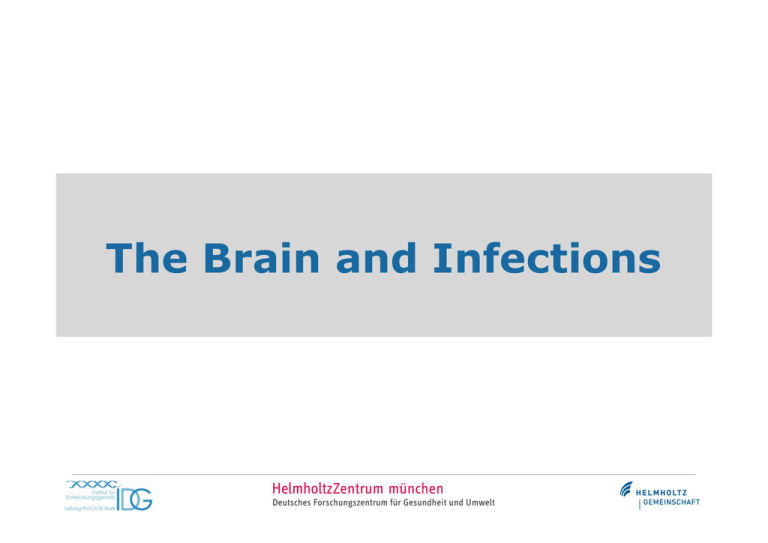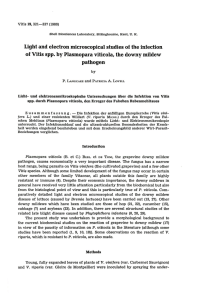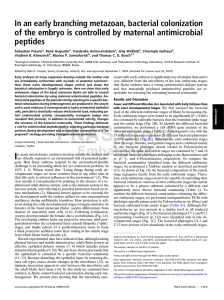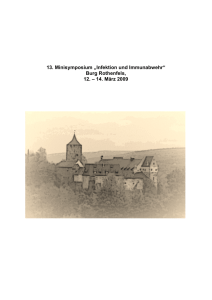The brain and infections
Werbung

The Brain and Infections What do we talk about • Infections of the brain • How do the infectious particle enter the brain • Bacterial infections • Viral infections – HSV-1 infection – Rabies infection – Tick borne encephalitis – HIV What do we talk about • Infections of the brain • How do the infectious particle enter the brain • Bacterial infections • Viral infections – HSV-1 infection – Rabies infection – Tick borne encephalitis – HIV Infections of the brain • lead primarily to inflammation of the brain • Depending on the localisation of the inflammation clinically one talks about – Meningitis – Enzephalitis – Myelitis Meningitis • Inflammation of the meninges • Dura mater • Arachnoidea • Pia Mater • Symptoms • Fever • Headache • Stiffness of the neck • Phonophobia • photophobia Encephalitis • Inflammation of the brain • Symptoms • Fever • Headache • Phonophobia • Photophobia • Mentally disturbed • Epileptic seizures Meningitis/Encephalitis What causes it? • Bacteria • Viruses (100) • Fungi • Parasites Meningitis/Encephalitis Demography of meningococcal meningitis. Red: meningitis belt Orange: epidemic zones Grey: sporadic cases only • Epidemiology • Bacterial • • • 3 / 100.000 Western 45.8 / 100.000 Brazil 500 / 100.000 in Meningitis Belt • 10.9 / 100.000 • Viral What do we talk about • Infections of the brain • How do the infectious particle enter the brain • Bacterial infections • Viral infections – HSV-1 infection – Rabies infection – Tick borne encephalitis – HIV Meningitis/Encephalitis • Entry point of microorganisms • Blood (hematogenous) – crossing Bloodbrain-barrier (BBB) • Per Continuum from infections in the headarea (e.g. Ostitis) • Peripheral nerves olfactory • Trauma Barriers in the brain 1. 2. 3. 4. Neurovascular unit (BBB) – see later Blood-CSF barrier – blood vessels fenestrated – ependyma with apical tight junctions Meninges barrier – Dura blood vessels fenestrated – tight junctions to separate SAS – Pia blood vessels similar to BBB Fetal CSF-brain barrier – specific sort of junctions (strap junctions 5. Adult ependyma – free exchange between CSF and brain The Blood-Brain-Barrier The Blood-Brain-Barrier Function of the BBB • Supply of brain with essential nutrients • Regulates ionic transport to garantuee optimal neuronal function • Clears large proteins and metabolites • Protection against microorganism A) Transport of „energy“ across the BBB B) Maintenance of the BBB Pathways across the BBB Microbial traversal of the BBB 1.Transcellular 2.Paracellular 3.Trojan horse Microorganisms render the BBB leaky and use „natural“ receptors Entry via nerves – mainly viruses Examples: Rabies Herpes What do we talk about • Infections of the brain • How do the infectious particle enter the brain • Bacterial infections • Viral infections – HSV-1 infection – Rabies infection – Tick borne encephalitis – HIV Bacterial meningitis - What is it? Bacterial meningitis is a serious infection of the spinal cord and the fluid that surrounds the brain What causes it? • There are 3 main bacterial species that contribute to this disease: – Haemophilus influenzae type b (infants) – Neisseria meningitidis (Meningococcal) (elder children – college students) – Streptococcus pneumoniae (young kids – elderly) – Mycobacterium tuberculosis – Virtually all bacteria can elicit meningitis/encephalitis Treatment & Medication • Antibiotics • Vaccination Possible Prognose: je früher die Behandlung desto besser – daher rasch!!! • Völlige Erholung 71% • Folgen, keine Behinderung 9% • Mäßige Behinderung 4% • Schwere Behinderung 2% • Tod (mit septischen Verlauf) 7-14% What do we talk about • Infections of the brain • How do the infectious particle enter the brain • Bacterial infections • Viral infections – HSV-1 infection – Rabies infection – Tick borne encephalitis – HIV Viral meningitis / encephalitis • Tends to be more begnin than bacterial meningitis • Treatment with aciclovir if necessary • However also more severe cases Herpes virus Taxonomische Bezeichnung Synonym (Abk.) Subfamilie HHV 1 Herpes-simplex-Virus 1 (HSV 1) Alpha HHV 2 Herpes-simplex-Virus 2 (HSV 2) Alpha HHV 3 Varizella-Zoster-Virus (VZV) Alpha HHV 4 Epstein-Barr-Virus (EBV) Gamma HHV 5 Zytomegalievirus (CMV) Beta HHV 6 Beta HHV 7 Beta HHV 8 Kaposi`s sarcoma associated virus (KSHV) HSV-1/HSV-2 - infections: • short symptomatic outbreaks • lifelong latent infection • recurrence of latent HSV – periodically reactivation • stress • suppressed immune system HSV-2: HSV-1: • • primary oral infections infestation rate 85% in adults • • primary genital infections infestation rate 35 % in adults Herpesviridae - Latenz Persistenz kann durch kontinuierliche (low level) Replikation bei gleichzeitiger Immunevasion, durch kontinuierliche Neuinfektion oder durch latente Infektion ohne oder mit geringer Genexpression bewirkt werden Latenz durch • Integriertes Genom, das wie zelluläres Gen repliziert wird (Retroviren) • Episomale Genomreplikation bei minimaler Genexpression (Herpesviren, z.B. EBV) • Episomales Genom in terminal differenzierten Zellen (keine Zellteilung), das nicht mehr repliziert wird (z.B. HSV) Latente Infektion und Reaktivierung bei Herpesviren • Nach der Primärinfektion verbleibt das Virus dauerhaft im Organismus in nicht-infektiöser Form • Das virale Genom persistiert ohne Bildung infektiöser Viruspartikel • Episomale Erhaltung des viralen Genoms wird durch virale und zelluläre Faktoren bestimmt Einmal Herpes – Immer Herpes Lifecycle of HSV Akute Herpes simplex Virus-Enzephalitis Chronische Herpes simplex VirusEnzephalitis TEMPORAL LOBE What do we talk about • Infections of the brain • How do the infectious particle enter the brain • Bacterial infections • Viral infections – HSV-1 infection – Rabies infection – Tick borne encephalitis – HIV Rabies virus Rabies • Viral infection from bite of a “furious” rabid animal: Animal rabies: Wandering, aggression, biting, salivating • Virus travels from the bite to the brain, via nerves • Thus, variable latent period • A fatal zoonotic disease Human “dumb” rabies: fever, confusion, anxiety, encephalitis, death Rabies Bite ÆVirus grows in muscle ÆVirus enters sensory nerve ending ÆVirus travels to cord, brain ÆVirus grows in brain, ÆVirus travels to salivary gland and is secreted Rabies symptoms Symptoms • • • Symptoms often start within 3-7 weeks. In some cases, the virus can incubate up to one or more years. Death usually occurs within a week after symptoms appear. Symptoms in humans may include: – Pain, tingling, or itching at the site of the bite wound or other site of viral entry – Stiff muscles – Increased production of thick saliva – Flu-like symptoms, such as headache, fever, fatigue, nausea – Painful spasms and contractions of the throat when exposed to water (called hydrophobia) – Erratic, excited, or bizarre behavior – Paralysis – Pathology: Negri bodies NO TREATMENT VACCINATION Rabies and Neurobiology What do we talk about • Infections of the brain • How do the infectious particle enter the brain • Bacterial infections • Viral infections – HSV-1 infection – Rabies infection – Tick borne encephalitis – HIV Tick borne encephalitis (FSME - Frühsommermeningoenzephalitis) • Flaviviridae – single stranded RNA viruses • Transmitted by ticks Tick borne encephalitis (FSME - Frühsommermeningoenzephalitis) Symptoms • Only about 1030% do show symptoms • Fever • Neurological symptoms • Often full recovery Treatment • Symptomatic • Life long immunitiy Elderly have more severe symptoms What do we talk about • Infections of the brain • How do the infectious particle enter the brain • Bacterial infections • Viral infections – HSV-1 infection – Rabies infection – Tick borne encephalitis – HIV HIV-1 a retrovirus Zerebrale Manifestationen bei Aids Ätiologie opportunistische parasitäre und bakterielle Infektionen Erkrankung Toxoplasma-Enzephalitis 82 zerebrale Kryptokokkose Aspergillus-Enzephalitis luetische Meningitis tuberkulöse Meningitis bakterielle Meningoenzephalitis opportunistische virale Infektionen durch HIV-1 hervorgerufene ZNS-Läsionen 25% 27 40 17 2 1 93 HIV-Enzephalitis HIV-Leukoenzephalopathie vakuoläre Myelopathie lymphozytäre Meningitis Anteil 30% 9 3 1 2 5 87 Zytomegalievirus-Enzephalitis noduläre Enzephalitis (meist CMV) progressive multifokale Leukoenzephalopathie Herpes simplex-Enzephalitis Guillain-Barré-Syndrom Tumore Patienten 102 27% 35 34 13 11 23 primär zerebrale maligne B-Zell-Lymphome 12 sekundäre (metastatische) maligne Lymphome 11 6% HIV-1 in the brain HIV-Neuropathology Manifestation Prevalence at autopsie* HIV-positive microglia nodules 20 - 50% Multinucleated giant cells 25 - 60% Loss of neurons; dendrite alterations > Demyelinisation of white matter 70 - 90% Astrocytosis 30 - 60% 90% * Kolson & Pomerantz, 1996, J Biomed Sci 3: 389. HIV host-cell interactions in the brain: Potential envelope attachment molecules Table 4. Potential envelope attachment molecules and HIV-1 receptors on the surface of brain cells Molecules Expressed on CD4 and CCR5 chemokine receptor Macrophages/microglial cells 260 kDa protein Astrocytes 65 kDa protein Astrocytes Human mannose receptor Astrocytes Galactosyl ceramide Astrocytes, oligodendrocytes DC-SIGN BMVECs L-SIGN BMVECs Cell surface proteoglycans BMVECs CXCR4 Neurons Kramer-Hämmerle et al., 2005, VirusRes 111, 194-213 Modell f. HIV-induzierte Neuropathogenese Slide 37 aus Kramer-Hämmerle, S. et al., VirusRes. 2005 Selected effects of HIV factors on brain cells Env gp120 Tat Nef Neurons Apoptosis Depolarization; Apoptosis; Cell death; Alters electrophysiological properties; Astrocytes Impaired glutamate uptake; Promotes survival; NO up; Activation of cellsignalling pathways; Altered growth properties Macrophages/micro glial cells Release of TNF-α, ß-chemokines TNF-α up; Promotes monocyte infiltration (directly and via MCP-1) Release of proinflammatory factors Mechanisms of HIV proteininduced neuronal damage HIV protein-mediated activation of cell surface receptors (CXCR4, NMDA-R, Notch1) leads to alterations in signaling pathways such as GSK3 and CDK5. Under physiological conditions, these pathways modulate critical substrates involved in synaptic plasticity and neurogenesis, and dysregulation of these signaling cascades could result in synapto-dendritic damage and impaired neurogenesis.


